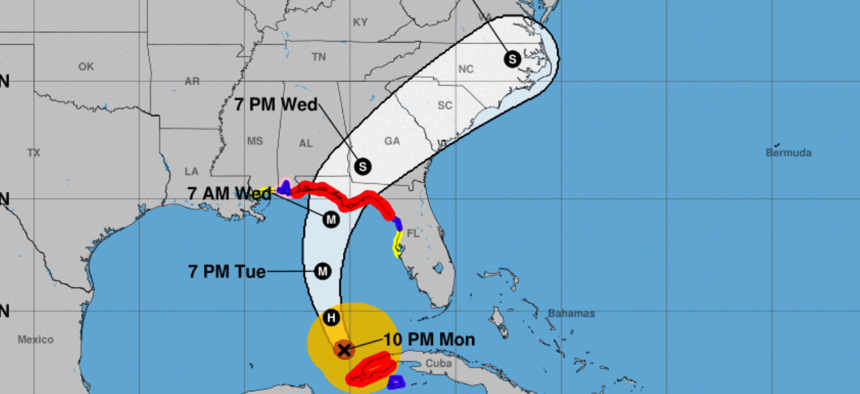Emergency Managers Mobilize in Florida Ahead of Hurricane Michael

The National Hurricane Center's forecast track for Hurricane Michael from Monday night. NHC / NOAA

Connecting state and local government leaders
A rapidly intensifying storm forces quick action to prepare.
Emergency managers, first responders and state and local officials in Florida are preparing for the arrival of Hurricane Michael, a rapidly intensifying storm moving toward the northeastern Gulf of Mexico and expected to make landfall on the state’s panhandle on Wednesday.
The tropical system, which reached hurricane status on Monday, may grow to Category 3 strength with winds up to 120 mph by the time of landfall, but Michael’s impacts are expected to be felt regionally. A variety of hurricane, tropical storm and storm surge watches and warnings have been posted for much of Florida’s Gulf Coast. Further inland, authorities in southern and central Georgia are anticipating tropical storm conditions and heavy rain as Michael weakens and moves into the Carolinas later this week.
Unlike Hurricane Florence, which formed more than a week before its landfall in North Carolina last month, Michael’s quick formation near the western tip of Cuba means that there’s less time for emergency managers, first responders and utilities to prepare.
While coastal counties in Florida’s panhandle are expected to face the brunt of the storm, places like Tampa Bay could see coastal flooding. Florida Gov. Rick Scott on Monday expanded a state of emergency to include 35 counties. "If this storm hits Panama City, Tampa could still have storm surge," Scott said at a news conference, according to the Tampa Bay Times.
There are mandatory evacuations in place for some areas, including Franklin and Wakulla counties in Florida’s panhandle.
Authorities in Wakulla County have urged residents to evacuate north to Leon County, where Tallahassee is located. Wakulla Sheriff Jared Miller posted Monday on Facebook that there won’t be emergency shelters opening in the county because the designated locations are only built for Category 2 strength winds. The sheriff also warned that storm surge levels in the low-lying areas of the county could reach 8-12 feet.
In Tallahassee, the Leon County Emergency Operations Center was activated on Monday and local officials were preparing to open shelters and assist residents with their preparations, including setting up sandbagging locations.
Electric utilities in the region have activated mutual aid agreements as assets and repair crews are positioned ahead of the storm.
“We are bringing hundreds of mutual aid personnel into the City of Tallahassee. Our goal is to have at least 150 crew members pre-staged in Tallahassee [Tuesday] in advance of the storm’s landfall with the remainder prepared to arrive Thursday,” Amy Zubaly, executive director of the Florida Municipal Electric Association, said in a statement on Monday. “Crews from Lafayette, Louisiana, will travel to Tallahassee tomorrow and will mobilize alongside crews from many of Florida’s public power utilities. Additional crews from several other states and parts of Florida are also standing by.”
Local officials faced major criticism for sluggish recovery in the days following Hurricane Hermine, which came ashore on Florida’s panhandle in 2016.
As the Tallahassee Democrat reported Monday, Leon County Administrator Vince Long sent an email to county commissioners outlining the county’s preparations and lessons learned from Hermine and Hurricane Irma:
"Commissioners, we are preparing for this to be a dangerous and powerful storm regardless of where it makes landfall, and as always our operational preparedness is extensive," Long said. "In the updates below, you will notice many activities that reflect enhancements to our preparedness capabilities resulting from lessons learned during Hurricanes Hermine and Irma."
Those include:
- Community and Media Relations launched preparedness and resilience messaging on social media, on the Leon County Emergency Information Portal, the Citizens Connect mobile app, and other public information methods.
- The county contacted AshBritt, the County's debris removal contractor, to put them on notice for possible future debris-related activities.
- Public Works teams began staging road barricades, preparing equipment to clear roads of downed trees and deploying sandbags.
- Emergency Management has begun outreach to local health care facilities to ensure emergency plans are in place and ready to go.
- Emergency Management and the Florida Department of Health began calling vulnerable populations on the special needs registry to ensure their well-being and safety, as well as to make sure they are informed.
- Continued coordination with 2-1-1 Big Bend to ensure they are ready to handle an increase in volume of calls for help.
The Florida state government has mobilized various agencies ahead of the storm’s arrival. According to a Florida Division of Emergency Management update on Hurricane Michael, Gov. Scott activated 500 Florida National Guard troops ahead of the storm with 5,500 soldiers and airmen available for activation; the Florida Highway Patrol is preparing to activate approximately 342 state troopers on 12-hour shifts; the Florida Department of Transportation has suspended construction projects; and the Florida Department of Health has requested five ambulance strike teams and 35 special needs shelter teams and is working with county health departments on response.
Michael Grass is Executive Editor of Government Executive’s Route Fifty and is based in Seattle.

NEXT STORY: Airbnb Operator Seeks to Appeal More Than $1 Million in City Fines





